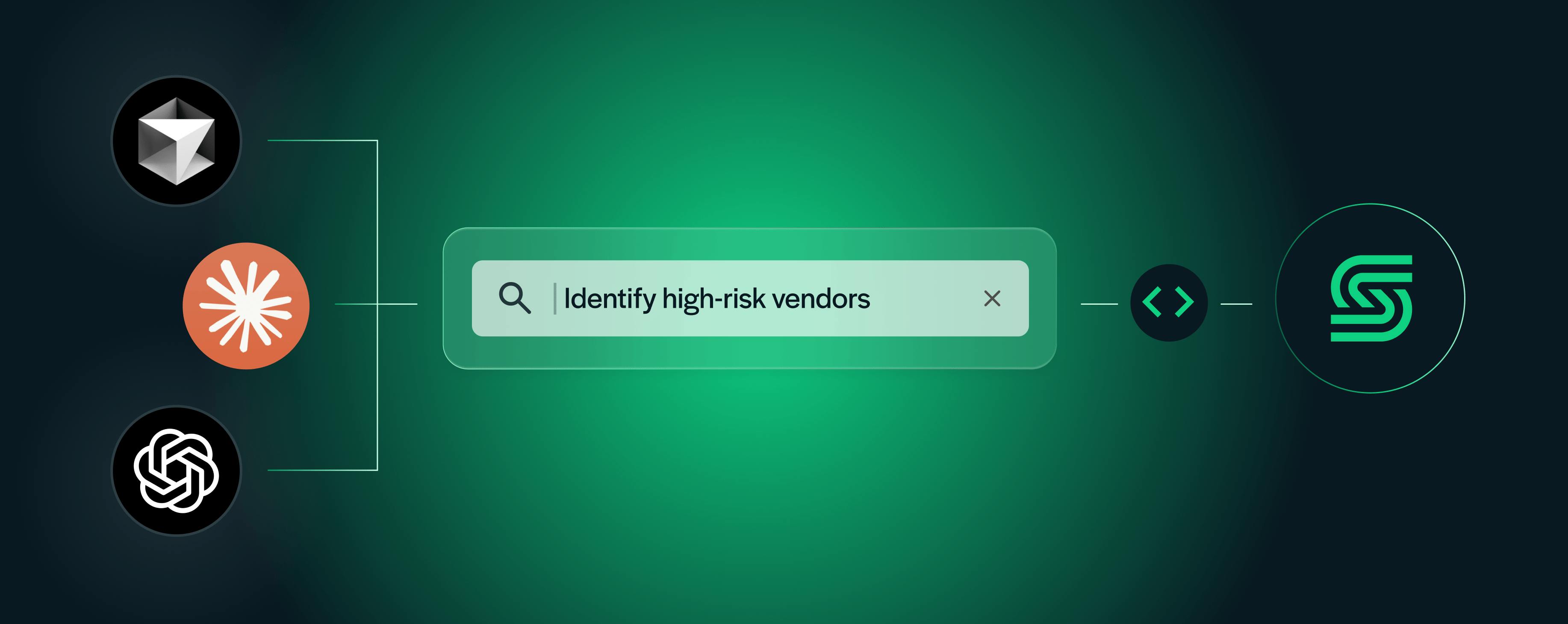
Introducing the Secureframe MCP Server: Compliance Access for AI Assistants
Emily Bonnie
Senior Content Marketing Manager
As AI tools like Claude, Cursor, and ChatGPT continue to reshape how we interact with enterprise data, one thing is becoming clear: the future of compliance isn’t just automated. It’s conversational, context-aware, and woven into the tools security and compliance teams already use.
Today, we’re excited to announce the Secureframe MCP Server, now available in public beta. This read-only server allows AI assistants and developer tools that support the Model Context Protocol (MCP) to query your Secureframe compliance data in real time.
What’s possible with the Secureframe MCP server
With just a natural language prompt, you can surface failing controls, investigate high-risk vendors, or check on user compliance status across frameworks like SOC 2, ISO 27001, CMMC, and FedRAMP.
You can use the MCP server to:
- Check compliance and framework progress
- Identify issues in security controls or compliance tests
- Review personnel and device status
- Investigate third-party and vendor risk data
- Understand audit scope across code repositories and integrations
“This is a powerful step forward for our customers,” said Shrav Mehta, Founder and CEO of Secureframe. “By opening up read-only MCP access, we’re helping teams tap into their compliance data wherever they work. Whether that’s an IDE, an AI assistant, or a custom interface, it’s all about making compliance easier, more accessible, and more integrated with your daily workflow.”
How the Secureframe MCP server works
The Secureframe MCP Server implements the open Model Context Protocol, allowing AI-powered tools to access key compliance data through Secureframe’s platform. The server provides read-only access to 11 endpoints that cover the most critical areas of your compliance program, including security controls, test results, vendor risk assessments, and more.
It’s designed for secure exploration and visibility. No write operations are supported, which ensures that all AI queries are non-disruptive and safe for your production environment.
The Secureframe MCP Server supports 11 read-only tools, each aligned to a key area of your compliance program:
| Tool | Purpose |
| list_controls | Explore controls by framework and health status |
|---|---|
| list_tests | View test results and pass/fail status |
| list_users | Audit personnel status and access |
| list_devices | Review managed devices and security posture |
| list_user_accounts | Inspect user accounts from connected integrations |
| list_tprm_vendors | Identify high-risk vendors |
| list_vendors | Access legacy vendor data |
| list_frameworks | View supported compliance frameworks |
| list_repositories | Understand audit scope across codebases |
| list_integration_connections | Monitor integration status |
| list_repository_framework_scopes | Map repositories to frameworks |
All tools support powerful Lucene-based search syntax so you can filter and find exactly what you need, just like you would in the Secureframe platform.
Unlocking AI-powered compliance workflows
When compliance data becomes instantly accessible through natural language queries, everyday workflows get faster, simpler, and more aligned with how teams actually work. The Secureframe MCP Server unlocks that experience by giving GRC leaders and developers a shared, AI-readable layer of context for ongoing compliance efforts.
Below are some of the most powerful ways early adopters are using the Secureframe MCP Server to streamline tasks, identify gaps, and drive action.
1. Spot failing controls before they become audit issues
Staying ahead of control health is central to maintaining compliance. With the MCP server, teams can quickly surface any failing controls, filtered by framework, owner, or severity. This gives GRC professionals a faster way to spot gaps and prioritize remediation without manually clicking through dashboards. AI tools can highlight these controls in context, helping teams understand what's failing and why, so they can take remediation actions sooner.
2. Surface high-risk vendors for faster reviews
Third-party risk management is one of the most time-consuming aspects of compliance. Identifying which vendors pose the greatest risk often involves digging through reports, questionnaires, and status updates. Using the MCP server, AI assistants can instantly query vendor data and pull out high-risk vendors that require immediate review. This not only saves time but supports a more proactive approach to vendor due diligence and ongoing third-party risk monitoring.
3. Streamline audit prep with real-time test insights
When an audit is on the horizon, failing tests become a critical focus area. The MCP server allows you to pull a real-time view of your failing tests, making it easier to assess your readiness and assign remediation tasks. Instead of hunting through spreadsheets or dashboards, GRC teams can use AI assistants to ask questions like, "What are the most recent failing tests in our ISO 27001 environment?" and get actionable results in seconds.
4. Identify inactive users and mitigate access risks
With the MCP server, you can query personnel records to find inactive users, contractors with lingering access, or accounts that may need to be offboarded. This is especially helpful in larger organizations where access reviews happen at scale. AI assistants can help flag these risks and support access certification efforts by surfacing the most relevant personnel data automatically.
Recommended reading

Secureframe Introduces AI Evidence Validation to Help Customers Pass Audits Faster and with Fewer Issues
Start using the MCP server in your workflows
The Secureframe MCP Server is now available in public beta to all Secureframe customers. You can connect it to AI tools like Claude, Cursor, or any client that supports the MCP specification.
To start exploring your compliance data, visit the GitHub or reach out to your Secureframe Customer Support team for guidance on connecting the server to your environment.
Note: The MCP server is read-only and designed to minimize risk, but we always recommend validating any AI-generated outputs before acting on them. Always verify that insights from AI assistants align with your organization’s security standards and compliance policies.
A smarter, more connected future for security and compliance
Secureframe is built on the belief that compliance should work with your tools, not against them. The Secureframe MCP Server brings us closer to that goal by creating a secure, standardized way to connect AI assistants to the systems that power your compliance program.
Whether you’re preparing for an audit, managing vendor risk, or reviewing test results with your team, the ability to access and understand your data in context makes the entire process faster and more intuitive.
Want to see the Secureframe MCP Server in action or explore how it fits into your workflow? Request a demo with a product expert — we’d love to show you what’s possible.
Use trust to accelerate growth

Emily Bonnie
Senior Content Marketing Manager
Emily Bonnie is a seasoned digital marketing strategist with over ten years of experience creating content that attracts, engages, and converts for leading SaaS companies. At Secureframe, she helps demystify complex governance, risk, and compliance (GRC) topics, turning technical frameworks and regulations into accessible, actionable guidance. Her work aims to empower organizations of all sizes to strengthen their security posture, streamline compliance, and build lasting trust with customers.